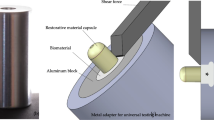Abstract
The present study was carried out to evaluate the effect of pre-luting surface treatments by 3 different etchant used at 3 different etching periods and their effect on shear bond strength of IPS Empress 2 luted to tooth by dual cure resin cement. Fifty samples of ceramic were divided into four groups as group I control group: No surface treatment, group II: Etched with Hydrofluoric (HF) acid (4.9%), group III: Etched with Ammonium bifluoride acid (9.4%) and group IV: Etched with Phosphoric acid (37%). Group II, III and IV were further divided into 3 Subgroups; namely A, B and C according to the etching periods (20, 60 and 120 s) respectively. The shear bond strength was determined by using a Universal testing Machine. The morphological changes of the surface treated ceramic samples prior to luting to tooth and mode of the fracture failure after shear bond test were observed by using a Scanning Electron Microscope. The mean shear bond strength was highest when IPS Empress 2 ceramic samples were surface treated using 4.9% Hydrofluoric acid gel and 9.4% Ammonium bifluoride acid for 120 s. The least mean shear bond strength was noticed in case of control group, where no surface treatment was done and samples treated by 37% Phosphoric acid. Thus it could be concluded, that Ammonium bifluoride could be an appropriate alternative to be used instead of HF acid. 120 s etching showed highest bond strength values for HF acid (4.9%) and Ammonium bifluoride (9.4%).







Similar content being viewed by others
References
El-Mowafy O, Brochu JF (2002) Longevity and clinical performance of IPS-Empress ceramic restorations—a literature review. J Can Dent Assoc 68:233–237
Ferrando JM, Graser GN, Tallents RH, Jarvis RH (1983) Tensile strength and micro leakage of porcelain repair system. J Prosthet Dent 50:44–50
Spohr AM, Sobrinho LC, Consani S, Sinhoreti MA, Knowles JC (2003) Influence of surface conditions and silane agent on the bond of resin to IPS Empress 2 ceramic. Int J Prosthodont 16:277–282
Stangel I, Nathanson D, Hsu CS (1987) Shear strength of the composite bond to etched porcelain. J Dent Res 66:1460–1465
Newburg R, Pameijer CH (1978) Composite resin bonded porcelain with a silane solution. J Am Dent Assoc 96:288–291
Bailey JH (1989) Porcelain-to-composite bond strengths using four organosilane materials. J Prosthet Dent 61:174–177
Bailey LF, Bennett RJ (1988) Dicor surface treatments for enhanced bonding. J Dent Res 67:925–931
Lacy AM, LaLuz J, Watanabe LG, Dellinges M (1988) Effect of porcelain surface treatment on the bond to composite. J Prosthet Dent 60:288–291
Kato H, Matsumura H, Tanaka T, Atsuta M (1996) Bond strength and durability of porcelain bonding systems. J Prosthet Dent 75:163–168
Bertolini JC (1992) Hydrofluoric acid: a review of toxicity. J Emerg Med 10:163–168
Cura C, Saraçoglu A, Cötert HS (2003) Effect of different bonding agents on shear bond strengths of composite-bonded porcelain to enamel. J Prosthet Dent 89:394–399
Kamada K, Yoshida K, Atsuta M (2001) Early bond strength and durability of bond between a ceramic material and chemically-cured or dual-cured resin luting agent. Am J Dent 14:85–88
Retief DH, Mandras RS, Russell CM, Denys FR (1990) Extracted human vs bovine teeth in laboratory studies. Am J Dent 3:253–258
Rueggeberg FA (1991) Substrate for adhesion testing to tooth structure—review of literature. Dent Mater 7:2–10
Jardel V, Degrange M, Picard B, Derrien G (1999) Correlation of photography to bond strength a etched ceramic. Int J Prosthodont 12:59–64
Watanabe I, Nakabayashi N (1994) Measurement methods for adhesion to dentine: the current status in Japan. J Dent 22:67–72
Hara AT, Pimenta LA, Rodrigues AL Jr (2001) Influence of cross-head speed on resin-dentine shear bonded strength. Dent Mater 17:165–169
Author information
Authors and Affiliations
Corresponding author
Rights and permissions
About this article
Cite this article
Pattanaik, S., Wadkar, A.P. Effect of etchant variability on shear bond strength of all ceramic restorations - an in vitro study. J Indian Prosthodont Soc 11, 55–62 (2011). https://doi.org/10.1007/s13191-011-0064-y
Received:
Accepted:
Published:
Issue Date:
DOI: https://doi.org/10.1007/s13191-011-0064-y




